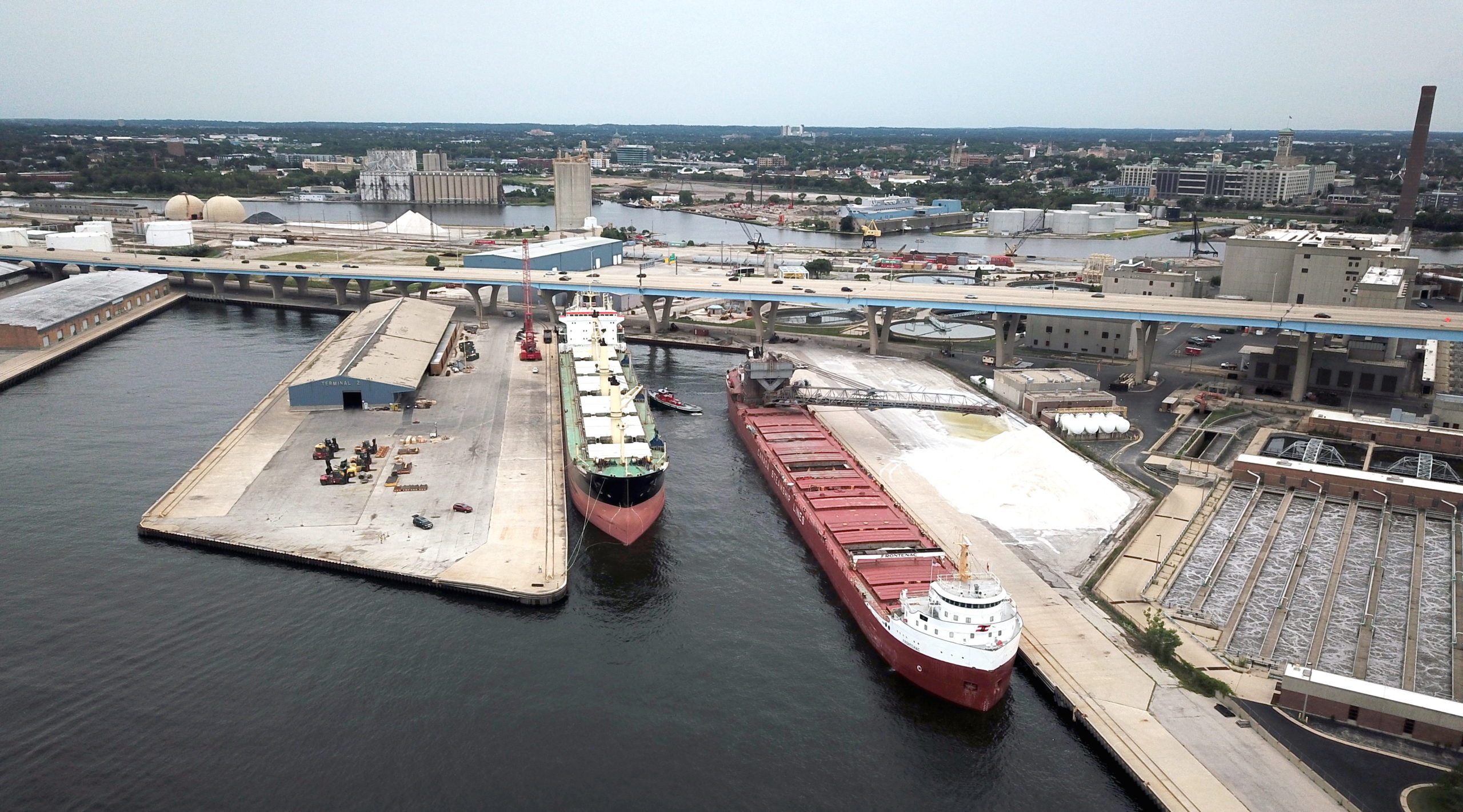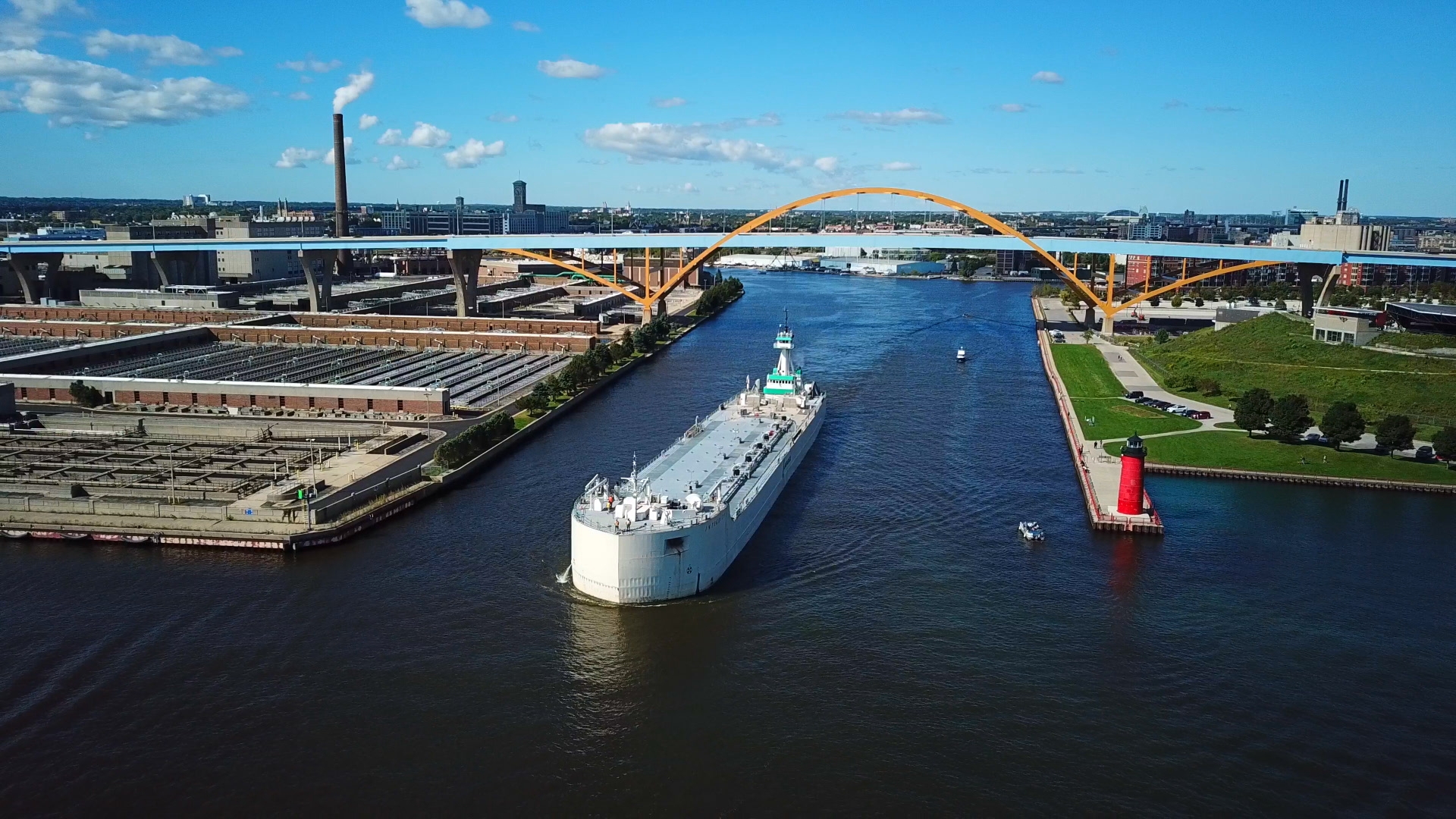
Shipping companies and ports around the world and on the Great Lakes are launching sustainability efforts to lessen their environmental impact, combat climate change, and improve their efficiency and images. With support from the Solutions Journalism Network, Great Lakes Now Contributor Kari Lydersen is reporting the four-part series “Sustainable Shipping.”
Read them here:
Are voluntary efforts enough to improve port sustainability?
Burns Harbor port tries to green Indiana’s industrial coast
And watch for the “Sustainable Shipping” segment in Episode 1031 of the Great Lakes Now monthly program.
A graceful wind turbine spins above the Port of Milwaukee, as ships glide in and out carrying grain, cement and other commodities from around the Great Lakes region and halfway across the world.
It is the only wind turbine powering a port in the U.S., and a symbol of the way ports are aiming to increase their sustainability and join the fight against climate change. Like many ports, Milwaukee’s is located in the midst of an urban area, so emissions into the air and water, noise, and light affect a surrounding population in an area also dealing with many other effects of decades of heavy industry.
The clean electricity from the wind turbine is especially meaningful since Wisconsin gets a large portion of its power from coal-fired power plants – and the turbine is offsetting that demand, powering the port administration’s entire operation and sending $13,000 worth of electricity back to the grid annually, meaning extra revenue for the city.
“Our little wind turbine is a huge success story, and we love her so much,” said port director Adam Tindall-Schlicht. “We know she’ll keep operating for years to come.”
Beyond the wind turbine, many environmental challenges for the port remain. Ports are inherently a major source of greenhouse gas emissions, as ships burn polluting fuel as they enter and dock at the port. And ports contribute to water pollution, with runoff from industries and commodities on-site, including from massive piles of road salt stored at Milwaukee’s port.
Larger goals
In an effort to become more environmentally friendly, the Port of Milwaukee joined Green Marine, a voluntary certification organization with member ports, port terminals, shipyards and ships across the Great Lakes and East, West and Gulf coasts.
To belong to Green Marine, ports must meet certain benchmarks in different focus areas and continually try to improve. Meeting baseline government and international regulations earns a score of 1 on a scale of 1-5 in different categories, and ports are required to move up to at least 2 in each category to maintain membership.
In 2020 the Port of Milwaukee scored 3 out of 5 on the Green Marine categories for air emissions, dry bulk handling and storage, and environmental leadership, and 2s on spill prevention, community relations and waste management.
Tindall-Schlicht noted that since a port typically needs capital expenditures approved by a commission or board, the Green Marine program can provide a framework for convincing them that sustainability investments are necessary and prudent.
Among other sustainability-related investments, the port built a new rail spur that has allowed them to take 1,400 trucks off the road, Tindall-Schlicht said. Since rail is much more efficient than trucks, that move improves air pollution along with road congestion.
Meanwhile the port – which handled 2.8 million tons of cargo last year – used a sustainability lens throughout their new 50-year capital management plan, which will guide future investments and improvements.
“It’s not enough to operate the port and make sure your assets are resilient, we’re also looking for new ways to operate those assets and operate the port,” said Tindall-Schlicht. “Incorporating metrics and sustainability has been one of the guiding pieces that we’ve launched in recent months that will inform our recertification and continued participation in Green Marine.”

Hoan Bridge by the Port of Milwaukee (Photo courtesy of Port of Milwaukee)
A chain reaction
Tindall-Schlicht said the port is hoping to offer incentives to ships to become Green Marine-certified, meaning they would get cost reductions on using the port or similar rewards for membership.
“We want to incentivize those companies that are making their own upgrades and reward them for bringing their environmentally sensitive vessels to our port,” he said. Such incentives would be part of the port’s tariff which is reviewed by the harbor commission. That commission is meeting in December, and he hopes to launch incentives next year.
Along with pushing ports to take action to move up the tiers of the program, Green Marine provides a forum for industry players to learn from each other.
“The information exchange and best practices shared between us and other certified ports is a really great benefit of participating in the program,” Tindall-Schlicht said.
He noted that one of the realms where he’s learned from other ports is shore power – the ability for ships to plug into electricity while docked at the port, so they don’t need to burn diesel fuel while stationary. Milwaukee has four such electrified berths.
Tindall-Schlicht said the port is ultimately interested in electrifying their on-site equipment and vehicles.
“We applied for a grant a year ago that would have allowed us to establish a charging station at the port for our future fleet and neighbors who live nearby, but we have not been successful in getting the grant,” he said. “I’m not discouraged and anticipate continuing on that effort.”
Sustainability-related investments like electrification can be expensive, and ports may find it hard to prioritize them especially when they are accountable to taxpayers.
Milwaukee’s wind turbine was built in large part through an energy efficiency and conservation block grant made available by the 2009 American Recovery and Reinvestment Act following the financial crisis.
A team effort
One of the port’s newest tenants is Marek Landscaping, a green design, construction and landscaping firm that is doing shoreline reconstruction and green space projects within the port’s footprint as well as around the region. Owner Mike Marek said most Milwaukee residents see the port as “a big industrial mystery,” with the most accessible view from a nearby bridge featuring the salt piles and an industrial landscape.
“Everything around there appears extractive,” he said, noting his company plans to help change that view by building more public access, green infrastructure and ecological amenities like floating islands and aquatic habitat within the port.
“Milwaukee was settled here because of the three rivers that come together, it’s such a rich estuary, and has this massive ecological role,” said Marek, who plans to join Green Marine as well. “We want that to be dusted off and uncovered again. I have a vision, I think a lot of other tenants and the port have a vision, of combining that ecological restoration with port infrastructure and improved recreational access and use.”
Lilith Fowler is executive director of the Milwaukee Harbor District, which works with the port and residents and businesses on revitalizing the area around Milwaukee’s harbor. She said residents find the port inaccessible and obscure, an image she’d like to see change.
“People don’t have a sense of the good things that are happening or the potential things that could happen,” she said. “The port has made some great strides in some areas, it has some really inspiring projects like the wind turbine, and we know for our region as a whole there’s always room to do better on water quality. We’re all working on it together.”
Tindall-Schlicht said helping the public better understand the port and improving community relations is a priority, especially since the Port of Milwaukee lies near residential areas adjacent to downtown, and populations disproportionately affected by other sources of pollution are close by.
The port takes a lead role in pushing for, carrying out and publicizing the ongoing cleanup of the official Area of Concern in the Milwaukee Harbor and estuary, where tons of contaminated sediment is being removed and stored in a secure landfill on port territory.
Tindall-Schlicht said that massive cleanup needs to happen “because 150 years ago, the waterfront industries did not care or sensibly approach their operations from the lens of sustainability and stewardship. One of the reasons Port of Milwaukee is a proud member of Green Marine is because that ownership, that stewardship and that passion for environmental care is part and parcel of what the port authority is.”
The port tries to interact directly with Milwaukee residents too. The port authority has public areas and green space on its land, and sponsors the city’s street festival Harborfest, and the event Chill on the Hill in the Bayview neighborhood.
“We find clever ways to engage with the community, to demystify the port, keep the doors open and offer the opportunity to give informational tours to members of the public,” Tindall-Schlicht said.
A question of doing more
After a fire started by arson severely damaged popular Three Bridges Park this summer, the port and shipping company Fednav – also a Green Marine member – donated trees and other support to rebuild the park, and the port is continuing to plant trees in the city.
Fednav’s subsidiary Federal Marine Terminal is a stevedoring company whose employees load and unload ships. FMT, which has terminals in Milwaukee and across the Great Lakes, is also a Green Marine member.
Louis Saint-Cyr, president of FMT and Fednav Direct, said the company works together with the ports where they rent space to improve sustainability.
“As part of that tenant agreement we have to be a good commercial partner,” he said. “We have very open, frank discussions about how we run the business… And we work with them on their long-term plans for green initiatives.”
Among other things, FMT is promoting solar power at its operations.
“How come we don’t have solar panels on all these rooftops” at ports, Saint-Cyr asked, adding that companies need to navigate different laws and incentives in each state to install solar.
Massive flooding from a winter storm in January 2020 caused $2 million of damage to Milwaukee’s port infrastructure. That was a “wake-up call” to the port and its tenants, and motivated further investments in resilience and in trying to curb climate change, both Tindall-Schlicht and Saint-Cyr said.
“There’s a lot of work ahead of us, but it’s a lot easier to initiate change and get things done when you don’t have to convince everybody,” Saint-Cyr said. “And now you don’t have to convince everybody – it’s just a question of doing more.”
Correction: A previous version of this story misstated the amount of damage the 2020 storm caused and the number of trucks that switching to rail reduced.
Catch more news on Great Lakes Now:
Sustainable Shipping: Burns Harbor port tries to green Indiana’s industrial coast
Green Marine: Are voluntary efforts enough to improve port sustainability?
Duckling Docks: Toronto installs floating docks to save drowning birds
Featured image: Port of Milwaukee (Photo courtesy of Port of Milwaukee)




